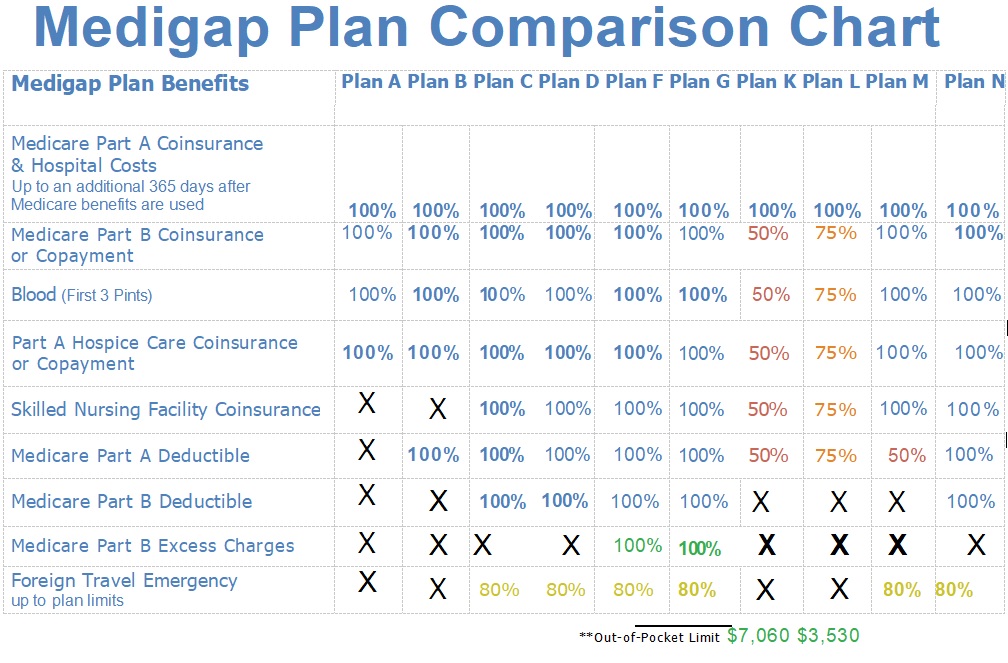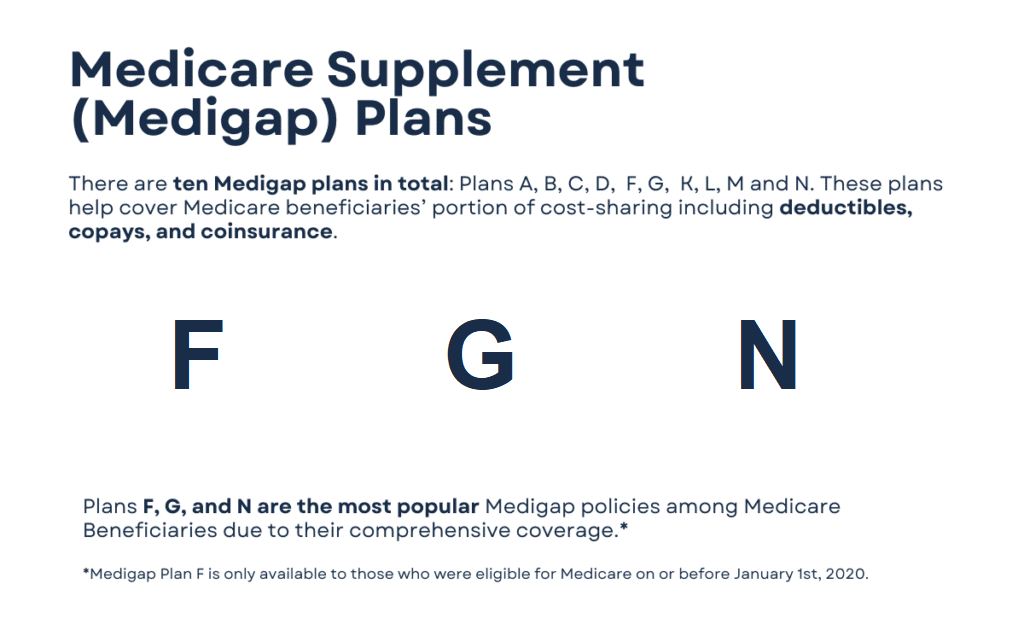Medigap plans and Medicare Supplement plans are two different names for the same type of insurance policy. They are one and the same.
What is Medigap Insurance?
Medicare Supplement plans, also known as Medigap plans, are categorized from A to N, with each plan providing coverage for different gaps in Medicare. To make the process of comparing Medigap plans easier, you can refer to the Medicare Supplement plans comparison chart below. This chart is regularly updated by the Centers for Medicare and Medicaid Services, although most plans do not undergo significant benefit changes on an annual basis.
Certain Medigap plans may have higher premiums but offer more extensive coverage, while others may have lower premiums but require you to pay for some of the Medicare gaps yourself. By comparing Medicare Supplements, you can determine which plans prioritize the coverage that is most important to you. Please note that the Medicare Supplement plans comparison chart below has been directly sourced from Medicare’s Guide to Health Insurance for individuals with Medicare.
Medigap plans, also known as Medicare Supplements, are insurance policies designed to cover the expenses that Medicare does not. By selecting a Medigap plan, you can ensure that your deductibles, copays, and coinsurance are taken care of.
What is the Best Medicare Plan?
Plan F and Plan G are the two most sought-after Medigap plans. As depicted in the Medigap comparison chart, Plan F provides coverage for all the gaps in Medicare. Plan G, on the other hand, is only slightly different but still manages to be a popular choice among beneficiaries.
Upon comparing Plans F and G side by side, it becomes evident that Plan G has only one distinguishing factor: the Part B deductible. If you analyze the annual premiums for Plan G and find that the savings outweigh the cost of the Part B deductible, then enrolling in Plan G would be a sensible decision.
Plan G has gained significant popularity over Plan F due to the fact that Plan F is no longer available for new Medicare enrollees. As of 2020, individuals who become eligible for Medicare are no longer able to select Plan C or Plan F, as they both cover the Part B deductible.
In recent years, there has been a growing interest in Plan N as well. Plan N offers lower premiums if you are willing to share some of the costs. However, unlike Plan F or G, Plan N does not provide coverage for excess charges. It is crucial to thoroughly research and comprehend the implications of this before enrolling in the plan.

Compare Medigap Plan Benefits
Plan F and Plan G are the two most sought-after Medigap plans. As depicted in the Medigap comparison chart, Plan F provides coverage for all the gaps in Medicare. Plan G, on the other hand, is only slightly different but still manages to be a popular choice among buyers.
Upon comparing Plans F and G side by side, you will immediately notice that Plan G has only one distinguishing factor: the Part B deductible. If you analyze the annual premiums for Plan G and find that the savings outweigh the cost of the Part B deductible, then enrolling in Plan G would be a sensible decision.
Plan G has gained significant popularity over Plan F due to the fact that Plan F is no longer available for new Medicare enrollees. As both Plan C and Plan F cover the Part B deductible, they are no longer accessible to individuals who become eligible for Medicare in 2020 or later.
In recent years, there has been a growing interest in Plan N as well. Plan N offers lower premiums if you are willing to share some of the costs. However, unlike Plan F or G, Plan N does not provide coverage for excess charges. It is crucial to thoroughly research and comprehend the implications of this before enrolling in the plan.
The 10 Supplement Plan Options
The above comparison chart for Medigap Plans presents a side-by-side analysis of all the plans. This enables you to easily identify the plans with the greatest benefits and those that offer the least coverage. As previously stated, Plan F and Plan G provide the highest percentage of benefits, resulting in minimal out-of-pocket expenses for you.

Here is a list of each plan, allowing you to effortlessly compare Medicare Supplement plans.
Medigap Plan A
Medigap Plan A provides the most fundamental coverage among all Medigap plans. Despite its simplicity, it ensures the payment of the 20% that Medicare does not cover for outpatient treatments, which is undeniably the crucial aspect of any Medigap plan. Plan A is mandatory for all Medicare insurance carriers to offer, although in certain states, there is no obligation for companies to provide it to individuals under the age of 65 who are on Medicare disability.
Medigap Plan B
Medigap Plan B provides coverage for all the benefits included in Plan A, while also taking care of the Medicare Part A hospital deductible. This Medigap plan acts as a supplementary insurance that pays for medical expenses after Medicare has made its payment. It is important not to mistake Plan B with Part B, as the latter is a component of your Original Medicare benefits that covers outpatient medical services.
Medigap Plan C
Medigap Plan C stands out as an exceptionally comprehensive supplement, providing coverage for almost all medical expenses except for Medicare excess charges. With this plan, you can rest assured knowing that it covers both your deductibles and the 20% portion that you would typically be responsible for in terms of outpatient costs. It’s worth noting that Medigap plans C and F have gained significant popularity among individuals seeking extensive coverage.
Medigap Plan D
Plan D provides coverage for a wide range of services, however, it does not include payment for the Part B deductible or any Medicare excess charges. As a result, it is considered to be one of the less favored Medigap plans. It is important to note that Plan D should not be mistaken for Part D, which specifically covers prescription drugs. These are two distinct aspects of Medicare coverage.
Medigap Plan F
Plan F has been the top-selling Medigap plan in the Medicare Supplement industry for a considerable period of time. It offers comprehensive coverage for all the expenses that you would typically have to pay for. This means that you won’t have to worry about any out-of-pocket costs for the services covered by the plan. It provides individuals with a sense of security, knowing that they won’t even have to pay a copay for visits to the doctor or stays in the hospital.
Additionally, there is an alternative option known as the high-deductible version of Plan F. This variation offers excellent Medigap coverage, but only after you have met a certain deductible amount.
Medigap Plan G
In recent years, Medigap Plan G has experienced a surge in popularity. It provides coverage for all the same benefits as Plan F, with the exception of the Part B deductible. Plan G often offers highly competitive premiums, making it a more cost-effective option compared to Plan F. Upon comparing Medicare Supplements between Plan F and G in most states, it is frequently observed that Plan G provides better value on an annual basis.
Medigap Plans K, L, and M
These plans provide limited coverage for specific benefits. For example, Plan K provides coverage for 50% of the majority of items, while Plan L covers 75% of most items. These three plans are not frequently requested by Medicare beneficiaries, resulting in limited availability from carriers. Nevertheless, in certain areas, you can often find competitive Medicare Supplement rates for these plans.
Medigap Plan N
Medigap Plan N was introduced in 2010, providing a cost-effective option with reduced premiums. However, in return for these lower premiums, policyholders are required to pay copays for specific services such as doctor visits and emergency room visits. It is important to note that this plan does not cover Medicare excess charges. While the lower premiums have appealed to many beneficiaries, some policyholders may find the additional bills for excess charges to be bothersome.
Accessing healthcare providers on Medicare Supplement Plans
With Medigap policies, you have the flexibility to choose any doctor who is part of the Medicare network. This means that you have access to a wide range of healthcare providers across the entire United States.
Medigap plans make it convenient for you to visit a doctor, regardless of which insurance company you have chosen for your Medigap coverage. As long as the doctor accepts Medicare, they will also accept your Medicare Supplement.
It’s important to note that there are other types of plans, such as Medicare Advantage plans, which have network restrictions. However, if you stick with Original Medicare, you have the freedom to see any doctor who participates in Medicare. In fact, approximately 93% of primary care physicians in the United States accept Medicare.
Types of Supplement Plans
There are three different types of Medicare Supplement plans available depending on your location. These options include community-rated, issue-age-rated, or attained-age-rated plans. Interestingly, in certain states, the attained-age rates tend to be the most economical choice. Conversely, in other states, the issue-age rates appear to be the most affordable option. It is important to note that even if you opt for an issue-age-rated Medigap policy, you may still experience annual rate increases due to the rising costs of healthcare.
2024 Medigap Plan Rates Comparison
When comparing prices for Medicare Supplement insurance, it is important to remember that the plans are standardized. While each company sets its own rates, the benefits for a Plan F remain the same regardless of where you purchase it. This applies to all other Medigap plans as well, making it easy for you to compare prices between policies.
In our evaluation process, we typically consider the top 3 – 5 carriers with the lowest prices for our clients. We also assess whether you qualify for a household discount and examine the rate increase history of these carriers.
Furthermore, we thoroughly review the financial ratings of the insurance companies. There are numerous highly-rated companies with A and B+ ratings available, so there is no need to choose a company with a lower rating.
Common Questions:
How many Medigap plans are available?
There are a total of 10 standardized Medigap plans along with 2 high-deductible plans. Nevertheless, the availability of these plans may vary depending on your specific circumstances and the state you reside in.
Can I change my Medicare plans?
You have the flexibility to modify your Medigap plan at any point throughout the year. Nevertheless, if you find yourself outside of your Medigap Open Enrollment window, you might be required to provide responses to health-related inquiries. It is possible that your health conditions could result in denial. It is worth noting that certain states have specific exceptions in place.
How much are Medigap plans?
The cost of a Medigap plan is determined by various factors such as your zip code, age, gender, and tobacco usage. Consequently, the premium for a Medigap plan in your locality may differ from that of an individual residing in another state.
What happens if my plan is phased out?
Starting from January 1, 2020, new Medicare beneficiaries are no longer eligible for Plan C and Plan F. However, individuals who are already enrolled in a Plan C or Plan F policy can continue to retain their existing coverage.
Takeaways
While there exist ten standardized plans, the most favored Medigap plans are Plan F, Plan G, and Plan N. It is crucial to comprehend all the available plan options in order to select the most suitable one that caters to your specific needs, as each plan provides different coverage for Medicare benefits. Regardless of the plan or carrier you possess, you have the freedom to visit any healthcare provider that accepts Original Medicare.
 Mario Arce
Mario Arce
I have been working with Medicare clients since 2016. I serve California members in San Bernardino & Riverside county.


